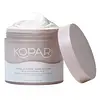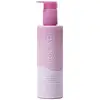What's inside
What's inside
 Key Ingredients
Key Ingredients

 Benefits
Benefits

 Concerns
Concerns

 Ingredients Side-by-side
Ingredients Side-by-side

Water
Skin ConditioningCocos Nucifera Oil
MaskingGlycerin
HumectantSqualane
EmollientEthylhexyl Palmitate
EmollientStearic Acid
CleansingStearyl Alcohol
EmollientMangifera Indica Seed Butter
Skin ConditioningCereus Grandiflorus Flower Extract
Skin ConditioningOpuntia Ficus-Indica Seed Oil
EmollientSodium Hyaluronate
HumectantPanthenol
Skin ConditioningTocopherol
AntioxidantGlycine Soja Oil
EmollientGarcinia Cambogia Fruit Extract
Skin ConditioningBetula Alba Bark Extract
MaskingXanthan Gum
EmulsifyingAcrylates/C10-30 Alkyl Acrylate Crosspolymer
Emulsion StabilisingCanola Oil
EmollientHydrogenated Lecithin
EmulsifyingEthylhexylglycerin
Skin ConditioningCitric Acid
BufferingSteareth-21
CleansingSodium Hydroxide
BufferingPhenoxyethanol
PreservativeParfum
MaskingWater, Cocos Nucifera Oil, Glycerin, Squalane, Ethylhexyl Palmitate, Stearic Acid, Stearyl Alcohol, Mangifera Indica Seed Butter, Cereus Grandiflorus Flower Extract, Opuntia Ficus-Indica Seed Oil, Sodium Hyaluronate, Panthenol, Tocopherol, Glycine Soja Oil, Garcinia Cambogia Fruit Extract, Betula Alba Bark Extract, Xanthan Gum, Acrylates/C10-30 Alkyl Acrylate Crosspolymer, Canola Oil, Hydrogenated Lecithin, Ethylhexylglycerin, Citric Acid, Steareth-21, Sodium Hydroxide, Phenoxyethanol, Parfum
Water
Skin ConditioningCaprylic/Capric Triglyceride
MaskingIsopropyl Palmitate
EmollientHelianthus Annuus Seed Oil
EmollientCocos Nucifera Oil
MaskingStearic Acid
CleansingGlycerin
HumectantCetearyl Alcohol
EmollientCoco-Caprylate/Caprate
EmollientPolysorbate 60
EmulsifyingRicinus Communis Seed Oil
MaskingShea Butter Ethyl Esters
EmollientCocos Nucifera Fruit Extract
EmollientAloe Barbadensis Leaf Juice
Skin ConditioningRosa Canina Seed Extract
EmollientChamomilla Recutita Flower Extract
MaskingTocopherol
AntioxidantPropanediol
SolventSodium Hydroxide
BufferingTetrasodium Glutamate Diacetate
Caprylyl Glycol
EmollientHexylene Glycol
EmulsifyingXanthan Gum
EmulsifyingSclerotium Gum
Emulsion StabilisingEthylhexylglycerin
Skin ConditioningPhenoxyethanol
PreservativeParfum
MaskingWater, Caprylic/Capric Triglyceride, Isopropyl Palmitate, Helianthus Annuus Seed Oil, Cocos Nucifera Oil, Stearic Acid, Glycerin, Cetearyl Alcohol, Coco-Caprylate/Caprate, Polysorbate 60, Ricinus Communis Seed Oil, Shea Butter Ethyl Esters, Cocos Nucifera Fruit Extract, Aloe Barbadensis Leaf Juice, Rosa Canina Seed Extract, Chamomilla Recutita Flower Extract, Tocopherol, Propanediol, Sodium Hydroxide, Tetrasodium Glutamate Diacetate, Caprylyl Glycol, Hexylene Glycol, Xanthan Gum, Sclerotium Gum, Ethylhexylglycerin, Phenoxyethanol, Parfum
 Reviews
Reviews

Ingredients Explained
These ingredients are found in both products.
Ingredients higher up in an ingredient list are typically present in a larger amount.
Cocos Nucifera Oil is obtained from the kernels of the coconut fruit. In other words, this is coconut oil.
Coconut Oil is rich in fatty acids with lauric acid making up the majority of these. It also contains linoleic acid. Due to this high fatty acid content, coconut oil helps trap moisture and soften skin.
Despite being antibacterial, coconut oil may not be great for acne-prone skin. It is comedogenic and may clog pores. This ingredient may not be safe for malassezia or fungal acne.
Note: Coconut Oil should not replace your sunscreen for UV protection. Studies show it only blocks about 20% of UV.
This oil is non-volatile and has a light scent.
The term 'fragrance' is not regulated in many countries. In many cases, it is up to the brand to define this term. For instance, many brands choose to label themselves as "fragrance-free" because they are not using synthetic fragrances. However, their products may still contain ingredients such as essential oils that are considered a fragrance.
Learn more about Cocos Nucifera OilEthylhexylglycerin (we can't pronounce this either) is commonly used as a preservative and skin softener. It is derived from glyceryl.
You might see Ethylhexylglycerin often paired with other preservatives such as phenoxyethanol. Ethylhexylglycerin has been found to increase the effectiveness of these other preservatives.
Glycerin is already naturally found in your skin. It helps moisturize and protect your skin.
A study from 2016 found glycerin to be more effective as a humectant than AHAs and hyaluronic acid.
As a humectant, it helps the skin stay hydrated by pulling moisture to your skin. The low molecular weight of glycerin allows it to pull moisture into the deeper layers of your skin.
Hydrated skin improves your skin barrier; Your skin barrier helps protect against irritants and bacteria.
Glycerin has also been found to have antimicrobial and antiviral properties. Due to these properties, glycerin is often used in wound and burn treatments.
In cosmetics, glycerin is usually derived from plants such as soybean or palm. However, it can also be sourced from animals, such as tallow or animal fat.
This ingredient is organic, colorless, odorless, and non-toxic.
Glycerin is the name for this ingredient in American English. British English uses Glycerol/Glycerine.
Learn more about GlycerinParfum is a catch-all term for an ingredient or more that is used to give a scent to products.
Also called "fragrance", this ingredient can be a blend of hundreds of chemicals or plant oils. This means every product with "fragrance" or "parfum" in the ingredients list is a different mixture.
For instance, Habanolide is a proprietary trade name for a specific aroma chemical. When used as a fragrance ingredient in cosmetics, most aroma chemicals fall under the broad labeling category of “FRAGRANCE” or “PARFUM” according to EU and US regulations.
The term 'parfum' or 'fragrance' is not regulated in many countries. In many cases, it is up to the brand to define this term.
For instance, many brands choose to label themselves as "fragrance-free" because they are not using synthetic fragrances. However, their products may still contain ingredients such as essential oils that are considered a fragrance by INCI standards.
One example is Calendula flower extract. Calendula is an essential oil that still imparts a scent or 'fragrance'.
Depending on the blend, the ingredients in the mixture can cause allergies and sensitivities on the skin. Some ingredients that are known EU allergens include linalool and citronellol.
Parfum can also be used to mask or cover an unpleasant scent.
The bottom line is: not all fragrances/parfum/ingredients are created equally. If you are worried about fragrances, we recommend taking a closer look at an ingredient. And of course, we always recommend speaking with a professional.
Learn more about ParfumPhenoxyethanol is a preservative that has germicide, antimicrobial, and aromatic properties. Studies show that phenoxyethanol can prevent microbial growth. By itself, it has a scent that is similar to that of a rose.
It's often used in formulations along with Caprylyl Glycol to preserve the shelf life of products.
Sodium Hydroxide is also known as lye or caustic soda. It is used to adjust the pH of products; many ingredients require a specific pH to be effective.
In small amounts, sodium hydroxide is considered safe to use. However, large amounts may cause chemical burns due to its high alkaline.
Your skin has a natural pH and acid mantle. This acid mantle helps prevent harmful bacteria from breaking through. The acid mantle also helps keep your skin hydrated.
"Alkaline" refers to a high pH level. A low pH level would be considered acidic.
Learn more about Sodium HydroxideStearic Acid is a fatty acid. It is an emollient, emulsifier, and texture enhancer.
As an emollient, stearic acid helps soften skin. It aids the skin's protective barrier by preventing water loss. It also provides a gentle cleansing effect without stripping away natural oils.
Stearic acid may also be used to enhance the texture of products. It can add volume and stabilize ingredients such as water and oil. This can help water and oil ingredients from separating.
Sources of stearic acid include animal or vegetable fats/oils such as coconut or shea. It can be naturally found in butter, cocoa butter, shea butter, vegetable fats, and animal tallow.
This ingredient may not be Malassezia folliculitis, or fungal-acne safe.
Learn more about Stearic AcidTocopherol (also known as Vitamin E) is a common antioxidant used to help protect the skin from free-radicals and strengthen the skin barrier. It's also fat soluble - this means our skin is great at absorbing it.
Vitamin E also helps keep your natural skin lipids healthy. Your lipid skin barrier naturally consists of lipids, ceramides, and fatty acids. Vitamin E offers extra protection for your skin’s lipid barrier, keeping your skin healthy and nourished.
Another benefit is a bit of UV protection. Vitamin E helps reduce the damage caused by UVB rays. (It should not replace your sunscreen). Combining it with Vitamin C can decrease sunburned cells and hyperpigmentation after UV exposure.
You might have noticed Vitamin E + C often paired together. This is because it is great at stabilizing Vitamin C. Using the two together helps increase the effectiveness of both ingredients.
There are often claims that Vitamin E can reduce/prevent scarring, but these claims haven't been confirmed by scientific research.
Learn more about TocopherolWater. It's the most common cosmetic ingredient of all. You'll usually see it at the top of ingredient lists, meaning that it makes up the largest part of the product.
So why is it so popular? Water most often acts as a solvent - this means that it helps dissolve other ingredients into the formulation.
You'll also recognize water as that liquid we all need to stay alive. If you see this, drink a glass of water. Stay hydrated!
Learn more about WaterXanthan gum is used as a stabilizer and thickener within cosmetic products. It helps give products a sticky, thick feeling - preventing them from being too runny.
On the technical side of things, xanthan gum is a polysaccharide - a combination consisting of multiple sugar molecules bonded together.
Xanthan gum is a pretty common and great ingredient. It is a natural, non-toxic, non-irritating ingredient that is also commonly used in food products.
Learn more about Xanthan Gum